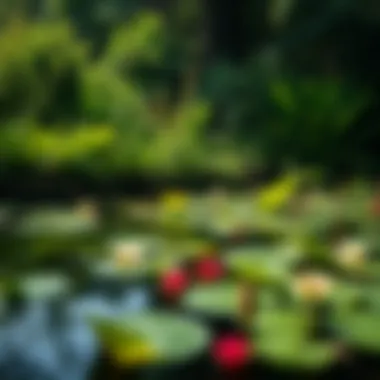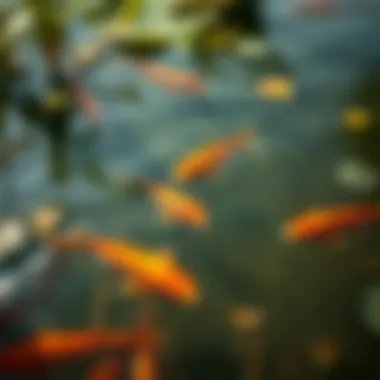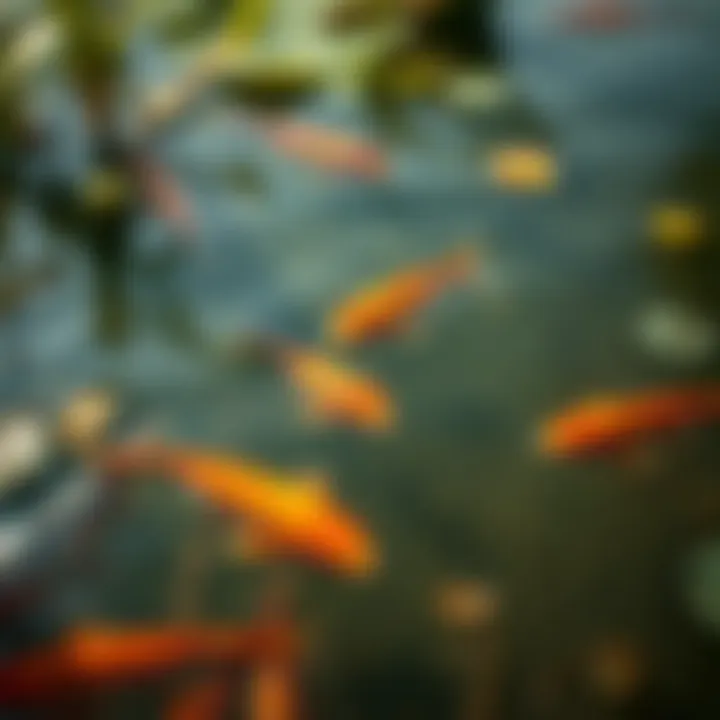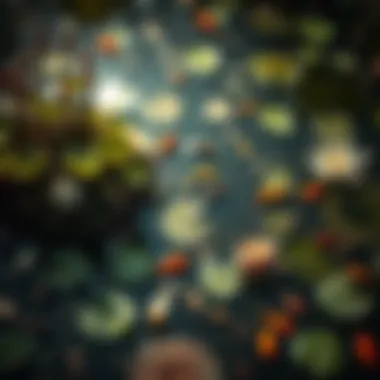Essential Practices for Effective Pond Maintenance


Intro
Maintaining a pond is no small feat. It requires a good balance between appreciating nature's beauty and understanding the delicate ecosystems at play beneath the surface. This guide provides a comprehensive look into what it truly takes to keep your pond thriving, whether you’re just getting your feet wet or you’ve already dived in.
From managing the environment around your pond to routine maintenance practices that keep it clear and clean, this guide has it all. Common challenges and innovative solutions will be discussed thoroughly. Not only will you gain insights into practical care strategies, but you will also learn how to sustain an ecosystem that not only looks good but is healthy and vibrant.
So, whether you are an experienced pond owner or a novice just dipping your toes in, the following sections will peel back the layers of pond upkeep, allowing you to see the nuts and bolts of maintaining an impressive aquatic landscape. Let's get started!
Prolusion to Pond Maintenance
Maintaining a pond isn’t just about aesthetics; it’s a critical practice that ensures the longevity and health of your aquatic ecosystem. Many pond owners might think that once the water is in place, they can just sit back and enjoy the view. However, neglecting regular maintenance can lead to issues that compromise both the beauty and functionality of your pond. Here’s why diving deep into pond maintenance matters.
Why Pond Maintenance is Essential
A healthy pond can be compared to a well-oiled machine, where each component plays a vital role. If one part breaks down, the entire system can suffer. Pond maintenance helps prevent problems like algae blooms, poor water quality, and fish kills. Here are a few key reasons why prioritizing maintenance is crucial:
- Improved Water Quality: Regular assessment of the water quality keeps harmful substances at bay. Without proper attention, factors like pH imbalance can lead to a toxic environment for fish and plants.
- Enhanced Aesthetics: A clean, well-maintained pond is pleasing to the eye and becomes a focal point in landscapes. It's where nature meets elegance, offering a serene space for relaxation.
- Biodiversity Support: A thriving ecosystem attracts various species. Without maintenance, invasive plants can jeopardize local fauna, effectively choking out native species.
- Preventative Measures: Regular maintenance allows you to address small issues before they escalate into major problems.
When it comes to staying on top of pond health, maintenance is not just a task; it's a commitment. It requires investing your time and resources to foster a sustainable aquatic lifestyle.
Understanding the Pond Ecosystem
To appreciate the importance of maintenance, it’s essential to understand the intricate web of life that exists within a pond. A pond isn't merely a body of water; it’s a dynamic ecosystem filled with interactions among various organisms, including microorganisms, plants, and animals.
- Water Chemistry: The water's chemical makeup influences everything from algal growth to fish health. Being familiar with essential elements like nitrogen, phosphorous, and dissolved oxygen can help you manage these components more effectively.
- Plant Life: Aquatic plants contribute significantly to the ecosystem. They produce oxygen, provide habitat for wildlife, and help stabilize the pond's bottom. However, they require attention to thrive without becoming overbearing.
- Wildlife Interaction: Fish, amphibians, and insects all play roles within this environment. Understanding predator-prey relationships is essential for avoiding population imbalances that could disrupt the entire system.
Maintaining a pond is akin to conducting an orchestra. Each creature and plant has its role, and you need to ensure they’re performing harmoniously. Understanding this interconnectedness is fundamental in making informed decisions about maintenance practices.
As you read on, keep in mind that successful pond maintenance revolves around a deep comprehension of your unique ecosystem. This guide aims to help you navigate this journey, revealing practical steps and insights to keep your pond thriving. For more resources about the ecology of ponds, explore the Encyclopedia Britannica.
"The best time to plant a tree was twenty years ago. The second best time is now." – Proverb
By integrating regular maintenance into your routine, you ensure that your pond remains a delightful sanctuary, not just for you but for the myriad of life it supports.
Key Components of Pond Health
Maintaining a healthy pond is no small feat, and understanding the key components of pond health is vital. A well-balanced pond can provide a habitat for wildlife, serve as an aesthetic feature, and play a role in nutrient cycling. Getting the components right—water quality, vegetation management, and balanced ecosystems—ensures not only the well-being of aquatic life but also enhances the beauty and utility of the pond.
Water Quality Management
To keep the pond thriving, effective water quality management practices are essential. Not merely a checkbox on a maintenance list, ensuring quality water paves the way for everything else.
Importance of pH Levels
The pH levels in your pond can be the make-or-break factor for aquatic life. Ideally, the water should hover between 6.5 and 8.5 on the pH scale. Levels outside this range might stress wildlife or even lead to a decline in fish populations. The key characteristic of pH is that it affects the solubility of nutrients, which in turn impacts how plants and animals thrive.
Managing pH isn't overly complex. Simple tests with pH kits are widely available. However, overly alkaline water may inhibit nutrient absorption, whereas highly acidic water might dissolve harmful toxins. Regular testing offers a unique opportunity— it allows early intervention before problems escalate.
Testing Water Parameters
Regular testing of water parameters is akin to checking a patient's vital signs; it's necessary to assess overall health. Parameters you should monitor include ammonia, nitrite, nitrate, and hardness. The key characteristic of this practice is the comprehensive data collection that allows for targeted interventions. For instance, high ammonia levels can indicate overfeeding fish or a dying ecosystem.
Innovative testers and kits are available now that make this easier than ever, so it's no longer labor-intensive. Over time, trying to manage a pond without regular tests can lead to disappointment and unexpected expenses.
Nutrient Balancing
Nutrient balancing is another essential aspect of maintaining pond health. Too many nutrients, especially nitrogen and phosphorus, can lead to unwanted algal blooms. However, a pond devoid of nutrients can quickly become lifeless. Thus, understanding the nutrient cycle is the key characteristic here, which helps in sustaining both flora and fauna.
Utilizing organic additives or even employing certain beneficial bacteria can help achieve balance. The unique feature of nutrient balancing is that it doesn't just focus on correcting current issues but also on preempting future problems by maintaining ideal levels. Failing to balance nutrients often leads to costly and time-consuming remedies down the road.
Vegetation Management
Vegetation in a pond, both beneficial and invasive, contributes significantly to its health. Properly managed, plant life can improve water quality, provide habitat, and elevate the aesthetic appeal of your pond.
Beneficial Aquatic Plants
Aquatic plants, such as water lilies and cattails, perform various functions that enhance pond health. They offer shade, reduce algae growth, and provide vital oxygen through photosynthesis. The key characteristic of these plants is their ecological role in maintaining balance.
On the downside, if not monitored, even beneficial plants can become overgrown and compete for resources. Planting a variety of these plants can maximize benefits while minimizing risks—so diversity is key.


Controlling Invasive Species
Invasive species, such as purple loosestrife or water hyacinth, can wreak havoc if left unchecked. Their rapid growth often leads to crowding, outcompeting native plants, and drastically altering habitats. The key characteristic of controlling these species lies in proactive measures. Regular monitoring and quick interventions can save a pond from an ecological imbalance and the headache of costly removal down the line.
Chemical treatments may offer immediate relief, but the sustainable solution often incorporates physical removal and introducing native species that can compete naturally. This not only resolves the immediate problem but fosters a healthier community overall.
Seasonal Plant Care
Whether it's spring blooms or autumn fades, seasonal plant care plays a pivotal role in a pond's health. The key characteristic of this practice is that it takes a proactive approach. Seasonal care includes pruning, reintroducing plants after winter, and monitoring growth patterns. This ongoing attentiveness helps prevent overcrowding and provides adequate space for each plant to thrive.
Neglecting this component can lead to overgrowth and decrease biodiversity, which harms the pond's ecosystem. Regular assessment during seasonal shifts enables a more dynamic approach to care, responding to the changing needs of both plants and water quality.
By focusing on the key components of pond health—water management and vegetation—the pond owner can create a flourishing environment that serves as a hub for life and beauty. It is this foundational understanding that allows us to maintain our ponds effectively.
Maintaining a Balanced Ecosystem
Maintaining a balanced ecosystem is crucial for the health and longevity of your pond. This balance not only supports a diverse array of wildlife, but it also enables the pond to be a sustainable habitat. A well-maintained pond ecosystem can prevent problems like algal blooms, nutrient imbalances, and invasive species infestation. Understanding the role of wildlife, managing populations, and ensuring diverse habitats are essential steps that keep everything in harmony.
Role of Wildlife in Ponds
Supporting Local Fauna
Supporting local fauna refers to the importance of having a variety of species that interact in a healthy and natural manner. Without such species, the pond may suffer from imbalances affecting water quality and plant growth. For instance, native frogs, newts, and dragonflies not only control insect populations but also become critical parts of the food web.
Benefits of Supporting Local Fauna:
- Biodiversity: Different species can enrich the ecosystem by fulfilling various roles, whether as predators, prey, or competitors.
- Pest Control: These animals can help minimize harmful insects that would otherwise proliferate.
Yet, it is vital to introduce only native species to ensure that the ecosystem doesn’t get thrown out of whack. Invasive species could decimate local wildlife, highlighting the delicate balance that exists in these ecosystems.
Creating Habitats for Aquatic Species
Creating habitats for aquatic species is another essential aspect of maintaining a balanced ecosystem. This involves facilitating areas like lily pads, submerged plants, and rocky bottom areas that provide shelter and breeding zones. These habitats encourage species such as fish and various invertebrates to thrive.
Benefits of Creating Habitats for Aquatic Species:
- Protection: Young fish can hide from predators, increasing their chances of survival.
- Nutrient Cycling: Various organisms contribute to breaking down organic matter, replenishing the ecosystem.
The challenge lies in ensuring that your approach does not lead to unwanted overcrowding or the growth of harmful plants. Thoughtful habitat creation helps establish a balanced scene where every organism has its place.
Avoiding Overpopulation Issues
Fish Stocking Guidelines
Fish stocking guidelines serve a critical purpose in maintaining an optimal pond population. Knowing the appropriate number of fish per gallon of water can prevent overcrowding and help ensure that the ecosystem remains viable. Different species have varying space and feeding needs, which makes it essential to do your homework before introducing new fish.
Key Considerations in Fish Stocking:
- Species Choice: Some species are better for community ponds, as they tend to be less aggressive.
- Quantity: Overloading the pond can lead to rapid waste accumulation, lowering water quality and stressing out the fish.
Following these guidelines can keep your ecosystem balanced, as harmony between fish populations leads to healthier waters.
Predator-Prey Relationships
Predator-prey relationships are foundational to the ecological fabric within a pond. Understanding these dynamics helps you maintain population levels among both predators and prey, fostering a healthy balance. For example, adding too many predatory fish can decimate smaller fish populations, resulting in an ecological disturbance.
Benefits of Understanding Predator-Prey Relationships:
- Stability: A balanced population allows fish to grow and thrive while keeping algae and other unwanted plant species under control.
- Ecosystem Resilience: Diversity in predator-prey relationships strengthens the ecosystem’s ability to react to environmental changes or stressors.
This understanding can sometimes be the difference between a healthy pond and one that struggles to maintain life. Therefore, be aware of each species' role in the aquatic community to keep the balance flowing smoothly.
By nurturing a balanced ecosystem, you position your pond to not just survive, but to flourish in its natural beauty.
For further guidance, visit resources like US Fish and Wildlife Service or National Park Service to gain more insights into local wildlife management and pond care.
Practical Maintenance Tasks
Maintaining a pond is not just about enjoying its beauty; it necessitates certain practical tasks that ensure the health of the ecosystem. Practical maintenance tasks directly contribute to the longevity of your pond, making it visually appealing and a thriving habitat for wildlife. Neglecting these elements can lead to serious issues like water quality degradation, excessive algae growth, or structural integrity problems. So, staying on top of these routines is crucial for any pond owner.


Routine Cleaning and Upkeep
Routine cleaning and upkeep form the backbone of successful pond maintenance. This is where a dedicated approach pays off by keeping the pond appealing and preventing the buildup of harmful substances. It’s not just about aesthetics; proper maintenance ensures a habitable environment for various species, from fish to amphibians.
Debris Removal Techniques
Debris removal involves clearing away fallen leaves, twigs, and other organic materials that can compromise water quality. Notably, this task is essential because accumulated debris can lead to a process called nutrient loading, which fosters algal blooms. Using tools like rakes or nets makes this process handy. Moreover, some pond owners might opt for skimmers or surface nets that can efficiently collect debris before it sinks and decomposes.
One specific benefit of debris removal is that it reduces the oxygen depletion in the water, as decomposing organic matter consumes oxygen. If left unchecked, poor oxygen levels can stress aquatic life, leading to fish kills or other unwanted issues. Regular removal keeps the pond clean and significantly aids in maintaining a balanced ecosystem.
Algae Control Measures
Algae control measures play a vital role in maintaining water clarity and quality. Excessive algae can turn a vibrant pond into a green soup, which is neither pleasing to the eye nor beneficial for aquatic life. Techniques like using beneficial bacteria or algaecides are popular choices for many pond owners.
Employing biological control methods, such as introducing certain fish species that eat algae, can be a more eco-friendly option. For instance, grass carp are known for their algae-eating tendencies. However, it’s crucial to take caution with these fish, as they can also overconsume other valuable plant species if not managed properly.
In summary, all these algae control measures not only prevent overgrowth but also engage more complex factors within the ecosystem. They allow for a healthier balance among various species and ensure that the pond does not become a nuisance.
Repairing and Enhancing Pond Structures
Repairing and enhancing pond structures is equally important for maintaining the functional aspects of your pond. Structures may include retaining walls, liner systems, or any additional decorative elements that contribute to the pond's design. Keeping these in good repair prevents water loss and enhances aesthetics, both significant factors for successful pond management.
Fixing Leaks in Liner Ponds
Fixing leaks in liner ponds is a critical task that requires both expertise and a keen eye. There’s nothing worse than watching your beloved pond slowly drain away due to undetected leaks. Identifying where leaks occur, usually along the seams or from punctures caused by sharp debris, is essential.
Most pond owners find solutions through repair kits that can patch up small holes effectively. These kits usually come with adhesives and patches compatible with various liner materials. While this approach is beneficial due to its cost-effectiveness, it demands the right application process for lasting results.
Ultimately, consistently monitoring and fixing leaks boosts overall pond health and saves you from unnecessary water loss, allowing for the continuation of an engaging aquatic environment.
Building and Maintaining Waterfalls
Building and maintaining waterfalls not only adds visual appeal but also benefits pond aeration and circulation. A well-constructed waterfall can create a tranquil soundscape while promoting oxygenation in the water. Circulation of water via waterfalls helps in keeping the water temperature stable, which is especially vital in warmer months.
While the initial setup might require considerable effort and investment, the long-term benefits can far outweigh these early challenges. Regular maintenance, such as checking the pump and clearing any obstructions, ensures that the waterfall remains a focal point rather than a problem area.
In the end, engaging with these practical tasks enriches the experience of pond ownership and encourages an environment that is not only beautiful but also sustainable.
Seasonal Considerations
Understanding the seasonal changes in your pond ecosystem is crucial for its sustainable health. Each season brings unique challenges and opportunities for maintenance. Ignoring these seasonal aspects can lead to problems such as water quality issues, unhealthy aquatic life, and unsightly debris build-up. This section covers various seasonal tasks that should be on every pond owner's to-do list, ensuring that your pond thrives year-round.
Spring Maintenance Tasks
Clearing Winter Debris
Clearing winter debris is a fundamental spring task that sets the stage for a vibrant pond ecosystem. As winter comes to a close, twigs, leaves, and other materials can accumulate at the bottom or along the edges of the pond. Removing this debris is essential as it can decay and release harmful nutrients, leading to unwanted algal blooms later in the season. A simple yet effective method is to use a net or a rake to gather up the remnants of winter's wrath.
One particularly notable characteristic of this task is its preventative nature. Keeping the pond clean not only beautifies it but also supports overall health, creating an inviting environment for fish and plants alike. However, one must be cautious with the aquatic life already stirring back to life. Careful maneuvering will ensure species such as frogs and beneficial insects are not disturbed. At the end of the day, clearing winter debris is a beneficial choice to foster a fresh start for your pond.
Reintroducing Fish and Plants
After a long winter, reintroducing fish and aquatic plants is a key aspect of maintaining a vibrant pond. Whether you've kept them indoors or they’ve spent the cold months in a deeper part of the pond, acclimating these living elements back into their summer homes is vital. Gradually introducing fish and plants prevents shock and ensures a smoother transition.
This process allows for a controlled reintegration of your pond's ecosystem, which encourages biological balance. A hallmark of this aspect is the careful monitoring of temperature differences, as sudden shifts can stress aquatic life. Additionally, by introducing native plants, you're promoting biodiversity. While the process requires time and patience, the reward is a lush and lively pond during the warmer months.
Summer Management Strategies
Monitoring Water Levels
Keeping an eye on water levels during summer is more than just good practice; it's necessary. Hot weather can lead to evaporation, reducing water levels drastically. Low water levels can stress fish and plant life, potentially leading to oxygen depletion. A proactive approach includes regularly checking levels and topping off with fresh water if necessary.
One key characteristic is that maintaining ideal water levels helps avoid fluctuations that can harm the aquatic environment. This strategy ensures that fish have enough space to thrive and that plants remain submerged. However, excessive topping off might dilute the water's beneficial minerals, so balance is essential. Overall, monitoring water levels allows for a well-functioning pond.
Controlling Temperature Fluctuations
Temperature regulation might not seem paramount, but it's a hidden cornerstone in pond management. As mercury rises, so do the challenges. High temperatures can decrease oxygen levels and create an imbalanced ecosystem. Implementing shade structures or adding water lilies can create cooler spots, aiding the overall health of your pond.
The uniqueness of this strategy lies in its dual purpose. It not only protects aquatic life but also makes the pond aesthetically pleasing. Yet, one must tread carefully; too much shade can hinder plant growth and diminish sunlight exposure needed for photosynthesis. Ultimately, controlling temperature fluctuations enhances the pond's resilience to seasonal demands.


Autumn Preparations
Preparing for Leaf Fall
As the trees begin to shed their leaves, preparing for leaf fall becomes crucial. Leaves left to decompose in a pond can lead to a build-up of organic matter, which can create more opportunities for algae to flourish come spring. The key here is proactive management—using leaf nets can be a simple yet effective strategy to catch leaves before they sink.
This task is beneficial as it preserves water quality and sets the stage for a healthier pond during the winter months. The downside is that frequent checks might be needed to ensure efficiency, especially during peak falling periods. Nevertheless, preparing for leaf fall can significantly reduce the labor required in the long run, supporting a cleaner ecosystem.
Winterizing Aquatic Plants
Winterizing aquatic plants is an essential action for responsible pond management, particularly for those that can't withstand frost. Certain plants may need to be relocated to warmer quarters or cut back to prevent damage. This careful planning not only protects your greenery but also contributes to the pond's aesthetic in the cold months.
What distinguishes this task is its focus on sustainability. By ensuring the survival of plants, you're fostering a resilient ecosystem that can bounce back in the spring. However, caution is important; some plants may not respond well to sudden changes. Winterizing, if done correctly, can ensure that your pond remains healthy and beautiful.
Winter Care Tips
Ice Management Techniques
As temperatures dip and ice begins to form, effective ice management is crucial. While some ice cover can insulate the pond, thick ice can deplete oxygen levels and harm aquatic life. Techniques such as using a pond heater or creating holes in the ice for air exchange can prove beneficial. These methods help maintain an oxygen supply that is vital for fish survival.
A noteworthy aspect of this task is its dual role. It maintains the pond's life support system while preventing further freeze damage. However, implementing these techniques requires active monitoring, which might feel burdensome, especially during harsh winters. Still, effective ice management ensures that your backside efforts from other seasons do not go to waste and that life continues beneath the ice.
Maintaining Aeration
Aeration isn’t just a fancy term; it's a necessity during winter months when oxygen levels can dwindle. Maintaining aeration systems or using aerators can prevent stagnant conditions. A lively pond allows fish to breathe and thrive even when it’s freezing outside.
The need for oxygen-rich water illustrates the core importance of this task. The unique feature here is leveraging technology to enhance natural processes; aeration systems create movement that helps distribute nutrients as well. The downside? They can consume energy and require maintenance, but the benefits to aquatic life and the overall pond health are indisputable. Regular aeration can mean the difference between a thriving pond come spring and one struggling to recover after winter.
Common Challenges and Solutions
Maintaining a pond can often feel like fighting an uphill battle. The link between a healthy ecosystem and successful pond management is undeniable, especially when it comes to addressing common challenges. Understanding these issues allows pond owners to nip problems in the bud before they escalate. Here, we'll break down some of the major obstacles that can arise and provide practical solutions to manage them effectively.
Addressing Algal Blooms
Algal blooms can hit your pond like a bolt from the blue. What starts as a few green tendrils could quickly spread, suffocating the life within your watery paradise. Primarily fed by excess nutrients, particularly nitrogen and phosphorus from fertilizers or decaying organic matter, these blooms often occur during warmer months when sunlight is more abundant.
To tackle this issue, consider implementing the following strategies:
- Nutrient Control: Regularly test your water to monitor nutrient levels. By reducing run-off from fertilizers or controlling feed given to fish, you can lessen nutrient inflow.
- Aeration Systems: Utilizing aeration helps improve water circulation and quality, hampering the growth of algae. Pumping oxygen into the water can create a hostile environment for unwanted algae while supporting beneficial aquatic life.
- Plant Coverage: Having a healthy population of aquatic plants can help outcompete algae for resources, reducing their prevalence.
"Stop algae before it has a chance to grow. Prevention is your best defence."
Handling Fish Kills
Fish kills are not just a source of heartbreak for pond owners but also indicate larger problems within the ecosystem. Factors leading to these unfortunate events can include sudden changes in temperature, poor dissolved oxygen levels, or the presence of toxins. The first response after discovering a fish kill should be to assess the water quality.
Here are steps to handle fish kills:
- Testing Water Quality: Use testing kits to check pH, ammonia levels, nitrites, and dissolved oxygen. Immediate action can save remaining fish.
- Immediate Aeration: Increase oxygen levels via pumps or aerators to aid fish that may be stressed.
- Consult Local Experts: If unsure about handling the situation, local agricultural extensions or fishery experts like www.extension.org can help diagnose and offer tailored solutions.
Managing Ongoing Contamination
Contamination in ponds often sneaks up on you, whether from runoff, discarded waste, or even leaching from nearby landfills. Over time, contaminants accumulate, impacting all facets of pond health including fish, plants, and microorganisms.
To manage and mitigate ongoing contamination, consider the following techniques:
- Buffer Zones: Planting native vegetation around the pond can act as a filter, absorbing pollutants before they reach the water.
- Regular Monitoring: Conduct routine assessments for contaminants using standard testing equipment or professional services to stay ahead of issues.
- Community Education: Encourage nearby landowners to follow environmentally-friendly practices. Collaborating with a community enhances the overall health of the local ecosystem.
By understanding these challenges and being proactive in your approach, you not only safeguard your pond’s health but also ensure it remains a vital part of the local ecosystem. For more information about water quality and pond management, visit the USDA or Aquatic Ecosystem Restoration Foundation.
Maintaining your pond takes effort, but the rewards of a thriving, healthy pond are worth every drop.
Epilogue
In the realm of pond maintenance, it is essential to recognize that continuous care is not just a box to check but a vital commitment to ensuring a thriving aquatic ecosystem. The interplay between water quality, wildlife, and vegetation makes it clear that neglecting any part can lead to a cascade of problems, affecting not just the fish and plants but also the overall aesthetic and health of the pond environment.
The Importance of Continuous Maintenance
Continuous maintenance involves consistent monitoring and assessment of your pond’s health. This multifaceted approach includes checking water quality, ensuring the vegetation is balanced, and managing the local wildlife presence. Here are several key points to illustrate its importance:
- Ecosystem Health: Regular upkeep maintains a balanced environment. Without it, adverse conditions can lead to algae blooms, stagnant water, and decreased oxygen levels, ultimately threatening aquatic life.
- Aesthetic Appeal: A well-maintained pond enhances your property’s visual appeal. It creates a serene atmosphere contributing to relaxation and enjoyment.
- Cost-Effective: Investing time in consistent maintenance can prevent larger issues that may require more intensive and costly interventions. Much like a car, if you ignore little problems, they can snowball into major repairs that hit your wallet hard.
- Biodiversity Support: A healthy pond fosters a thriving ecosystem. This means supporting various species, which can result in a more resilient and self-sustaining environment. It’s about playing the long game.
Maintaining a pond is akin to nurturing a garden; it requires attention and care. With seasonal variations and the natural changes that occur, being proactive is crucial. It’s not merely about fixing what’s broken; it’s about fostering a vibrant habitat that flourishes through the seasons.
Remember: Continuous maintenance does not have to be an overwhelming task. By developing a routine and prioritizing certain aspects of care, pond owners can ensure a healthy aquatic environment for years to come.
Implementing a regular maintenance schedule tailored to your specific pond’s needs ensures you won’t be caught off guard. Invest the time early, and reep the rewards with a flourishing ecosystem that’s a joy to observe and an asset to your property.







